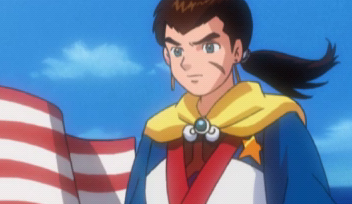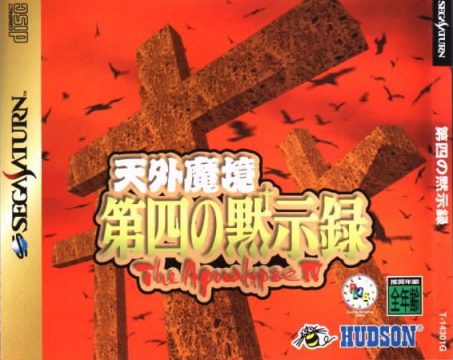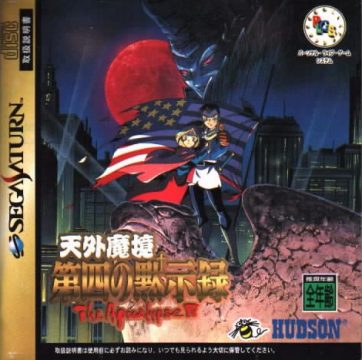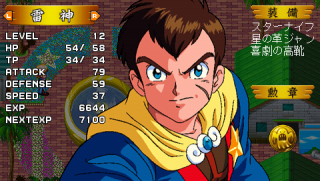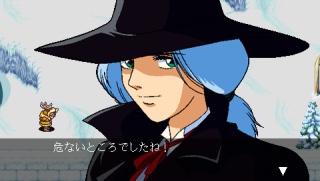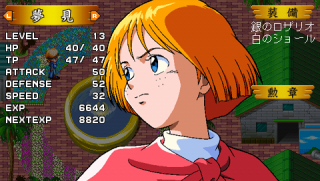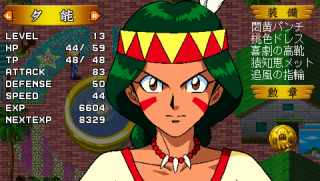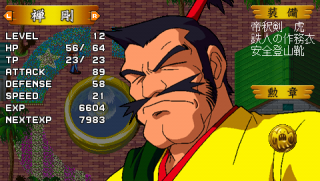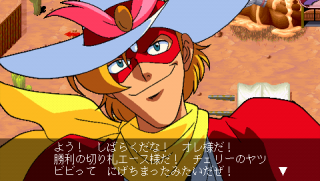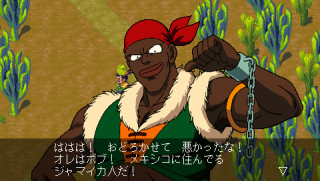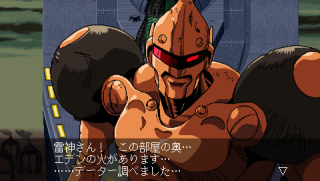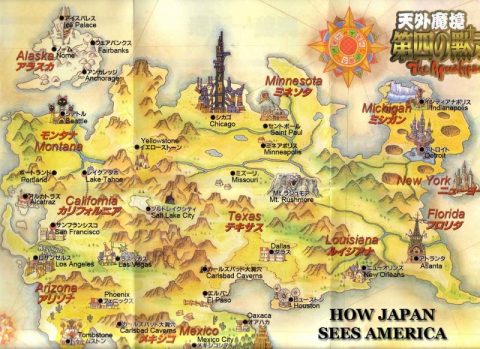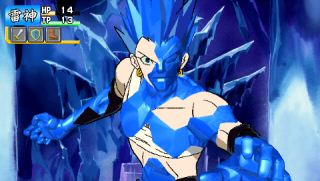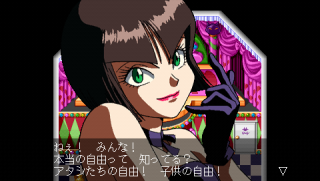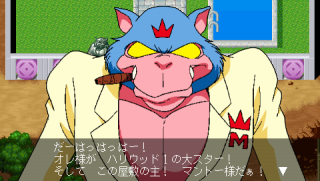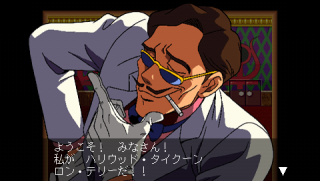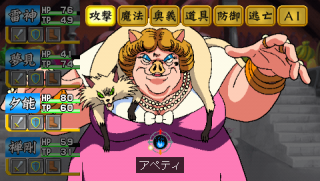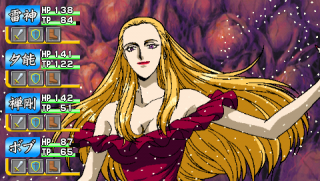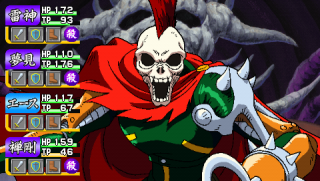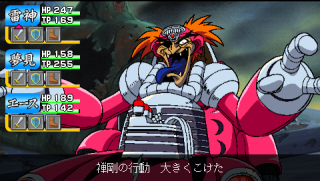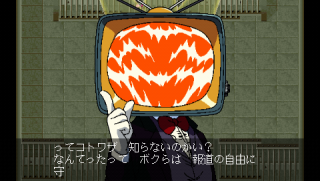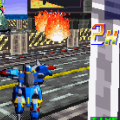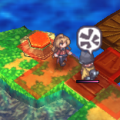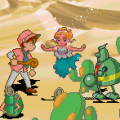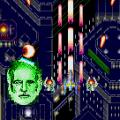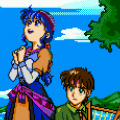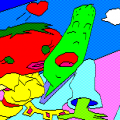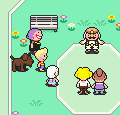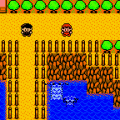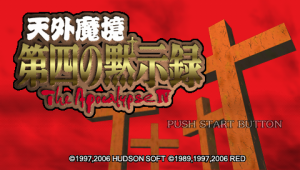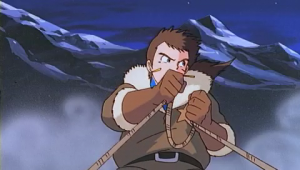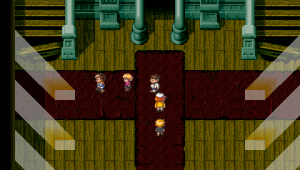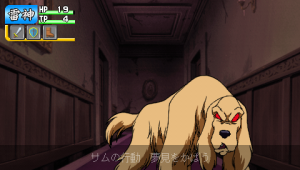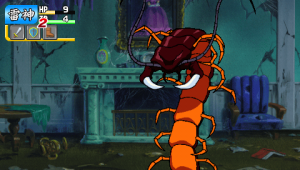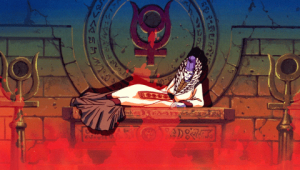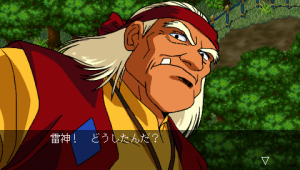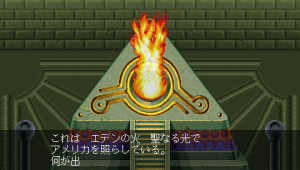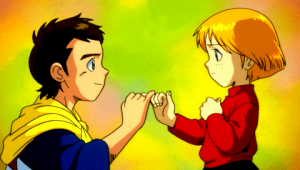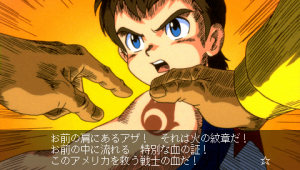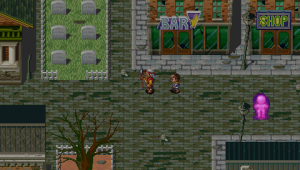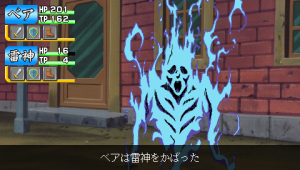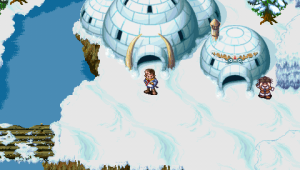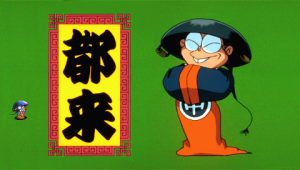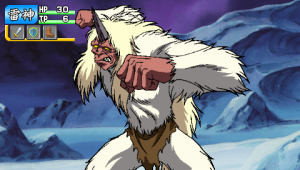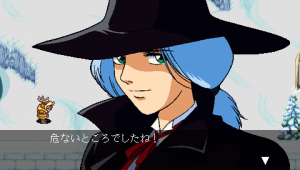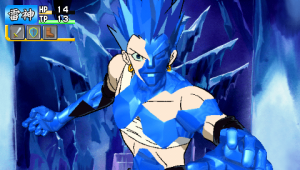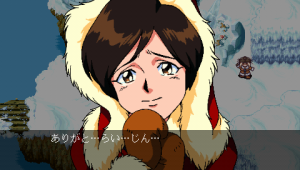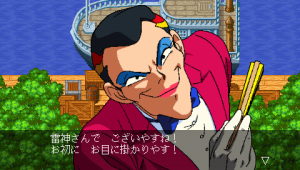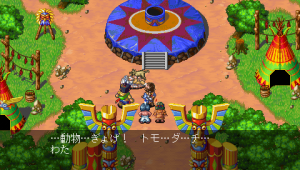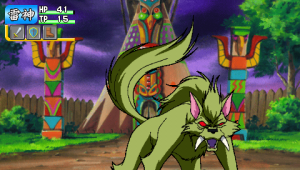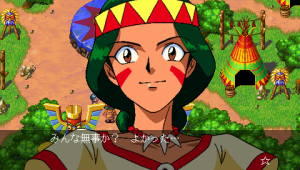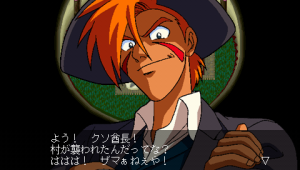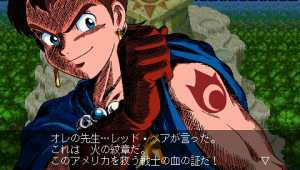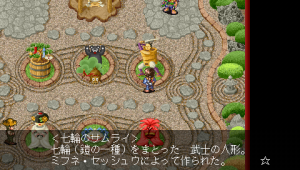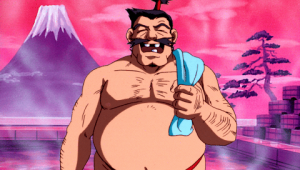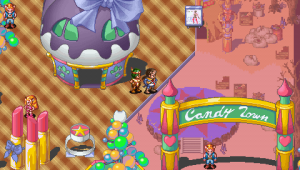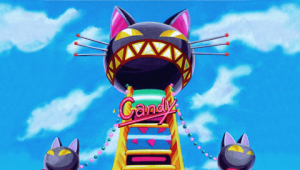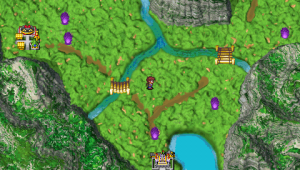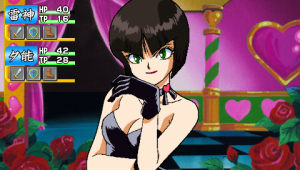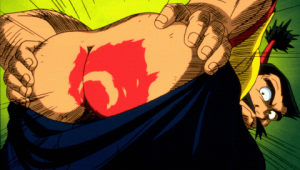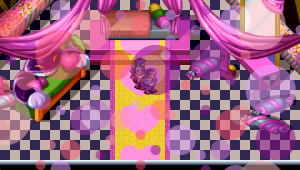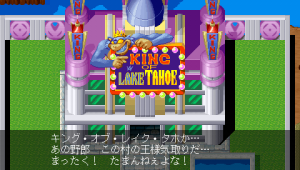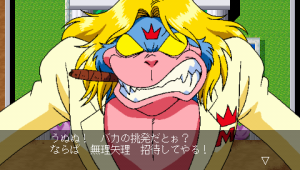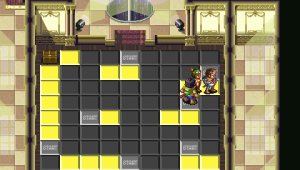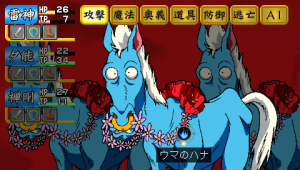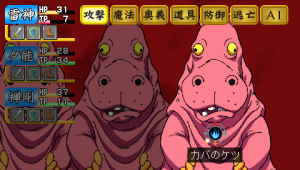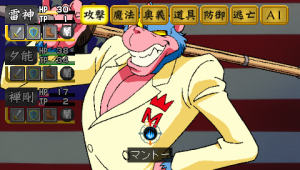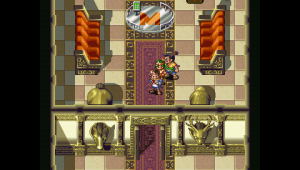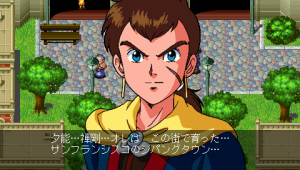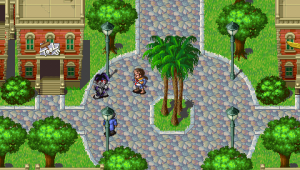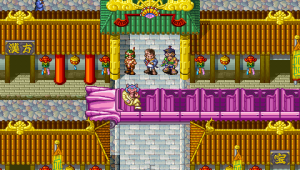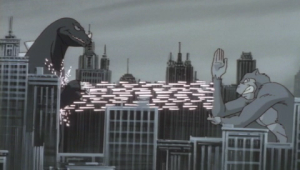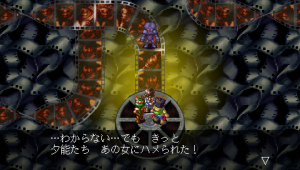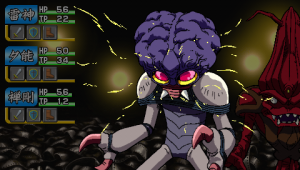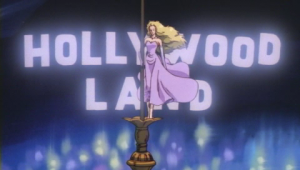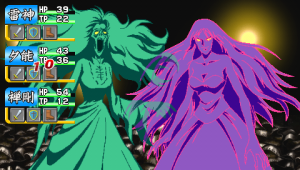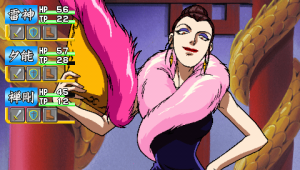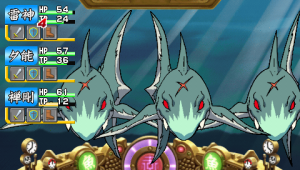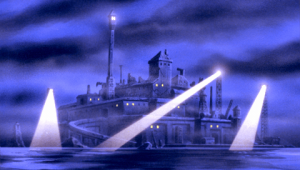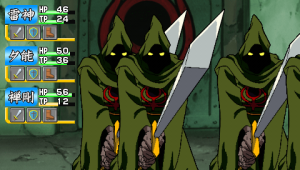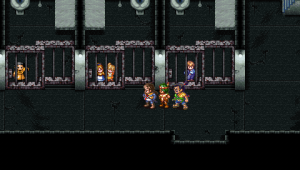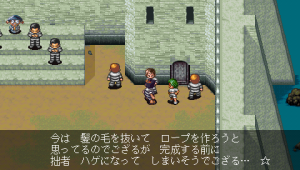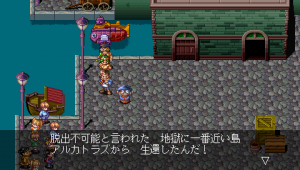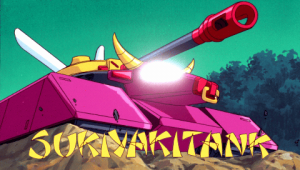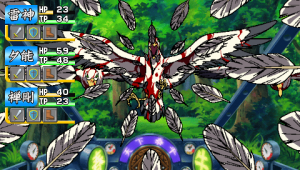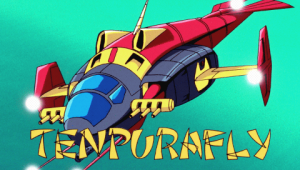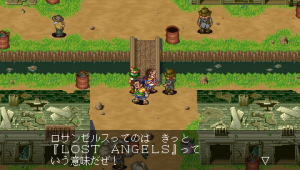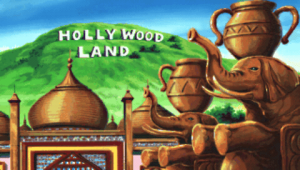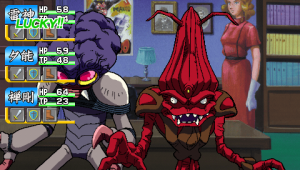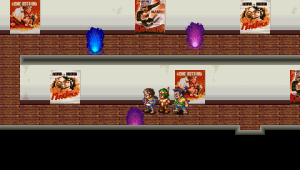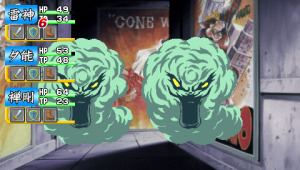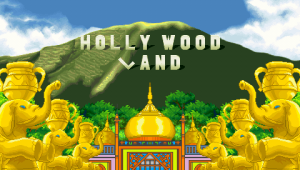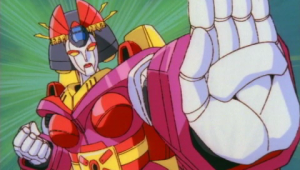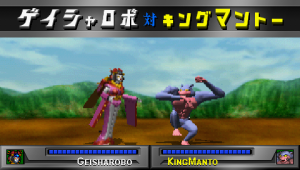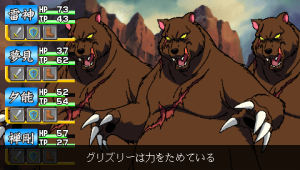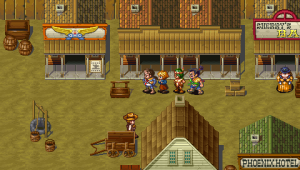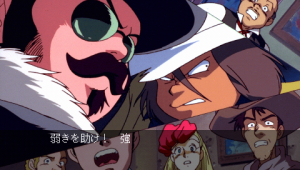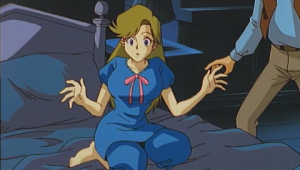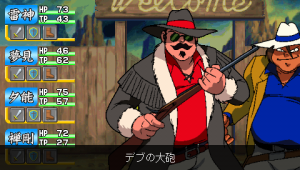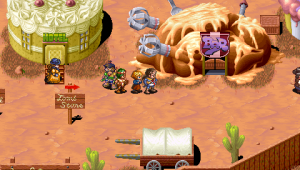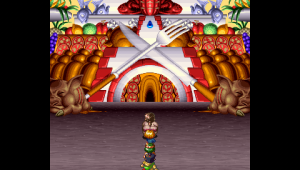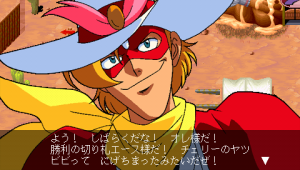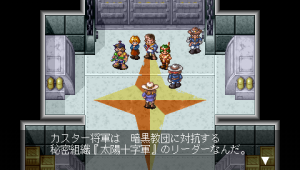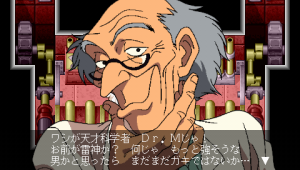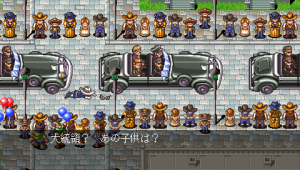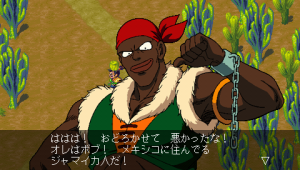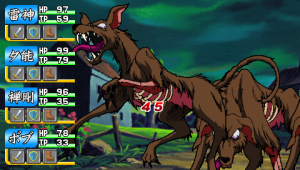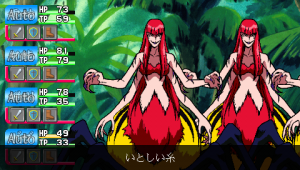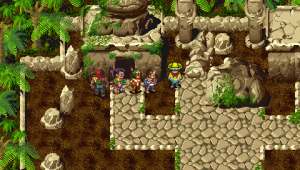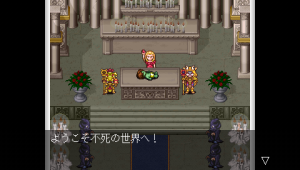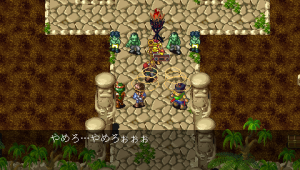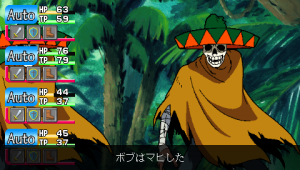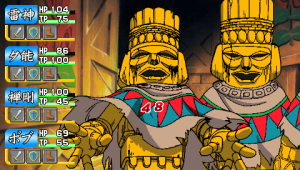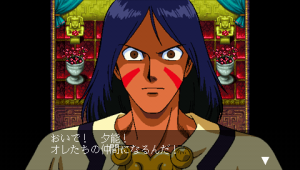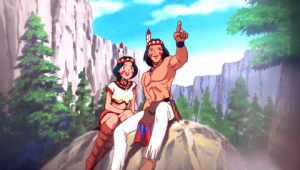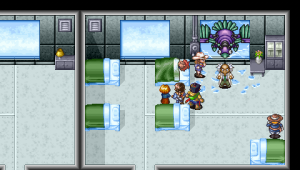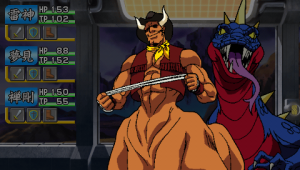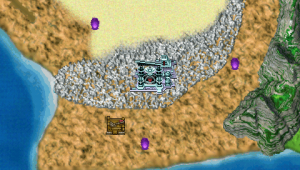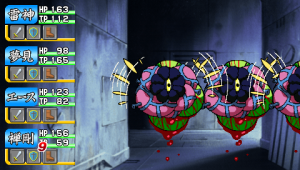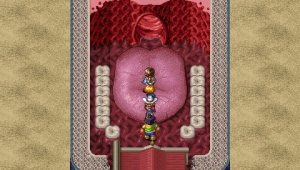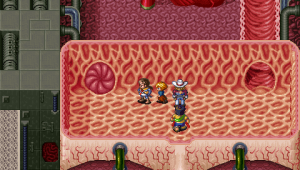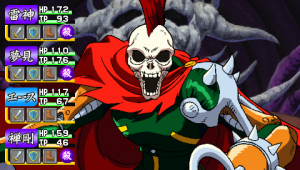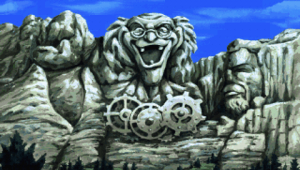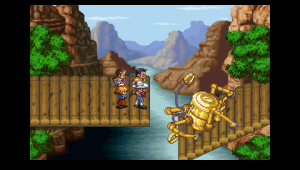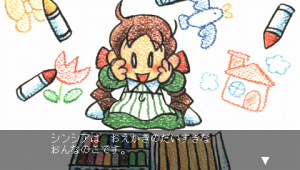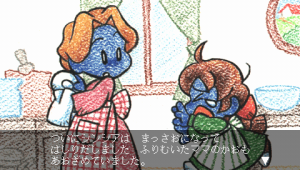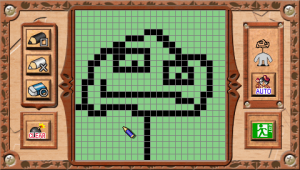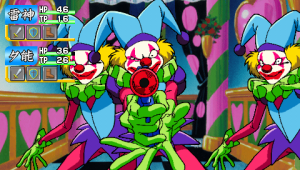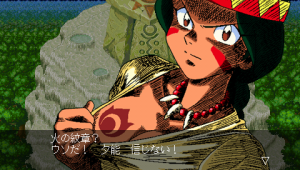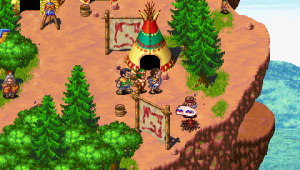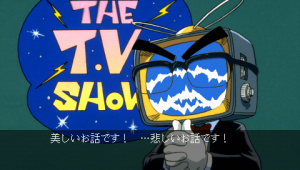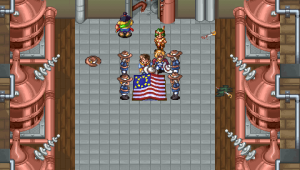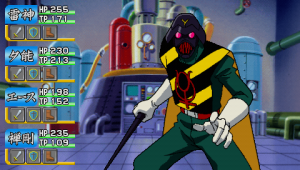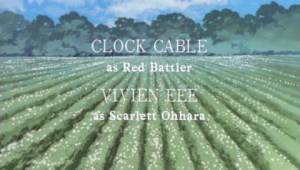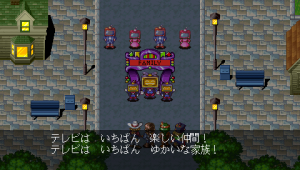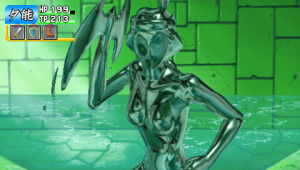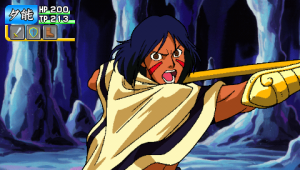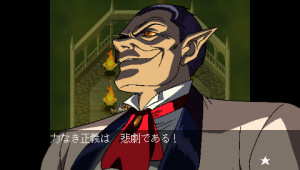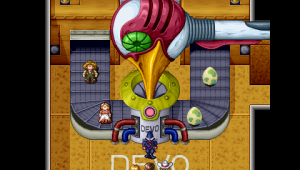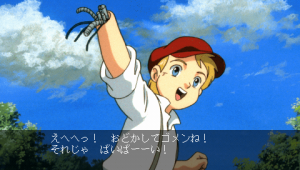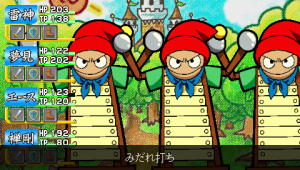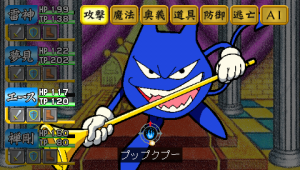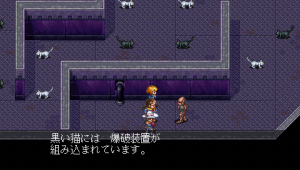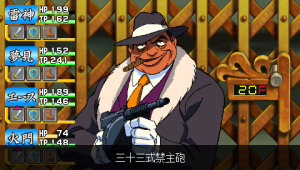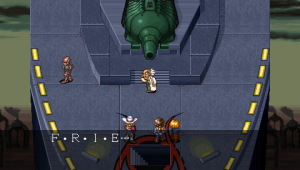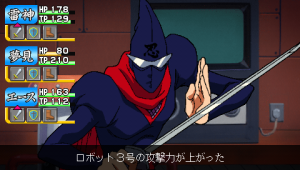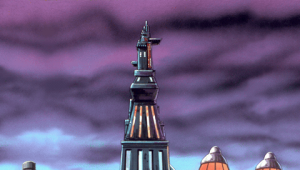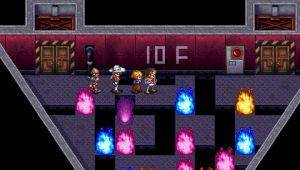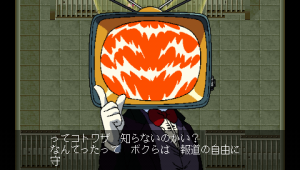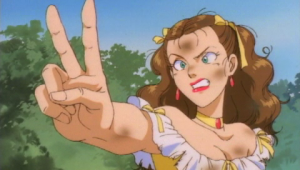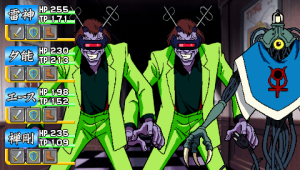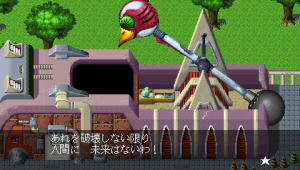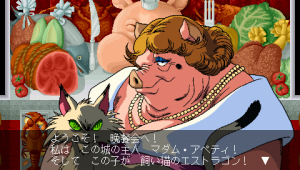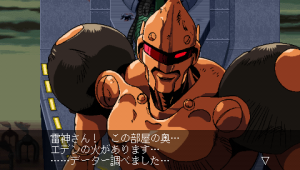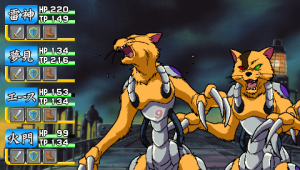The death of the PC-FX, plus assorted development issues, essentially spelled the end of the planned third Tengai Makyou game. So rather than resurrect the project for the new era of consoles, they just decided to do something completely different. So for the Saturn (and sole 32-bit) entry, they flipped the central concept of the series – rather than “a foreigner’s misguided view of Japan”, it became “a foreigner’s misguided view of the United States”. The result is one of the most hilarious (and oddly touching) JRPGs ever made.
The story initially started in 1895 Louisiana, focusing on the hero, Rizing, and his young friends, as they explore a haunted manor and accidentally awaken some kind of mystical spirit. It then jumps forward a few years (the prologue is technically a dream), with Rizing studying in Alaska as a demon hunter under the tutelage of the legendary Native American warrior Red Bear. The demonic scourge that has been plaguing the populace has become much worse, as the fires of Eden that burn in shrines around the country seem to be causing evil rather than preventing it. After a tragic incident sends Red Bear to his maker, Rizing heads off to mainland America to save its spirit, journeying around the various regions and saving them from evil at the hands of an evil cult.
Characters
Rizing
The stoic hero and brave demon hunter, he bears the seal of the Fire Clan. His name is spelled “Raijin” (雷神), meaning “thunder god”.
Seiya
A mysterious figure dressed all in black, who helps Rizing in Alaska and awakens his power. His true role is not known until near the end of the game. He looks like Tenjin from Tengai Makyou Zero, though their personalities are nothing alike and they aren’t otherwise related.
Yumemi
Rizing’s childhood friend and twin sister of their mutual friend, Sam. She’s only twelve years old, but fierce and kind-hearted. The two reunite in Hollywood, where she seeks to become an actress. Her name means “dream”.
Youno
A Native American warrior, well renowned as part of the “Three Warriors of Seattle”, including her friend Low Dog and lover Scar Wolf. Like Rizing, she bears the sign of the Fire Clan, which both she and the local populace believes is a sign of the devil, so she lives as an outcast. Her name is supposed to be “You know”, but in Japanese (夕能) means “evening”.
Zengo
An American who is obsessed with Jipang and fashions himself as a samurai. He was originally a butcher in a rural town until he left his wife and kids to set off for an adventure of self-fulfillment. He studied swordfighting by watching others so he basically has no idea what he’s doing, and some of his abilities can actually be detrimental to the party.
Ace
The alter ego of a civilian named Cherry Arps, he takes on this persona in order to overcome his cowardliness. He’s supposed to be one of the descendants of Kabuki from the PC Engine games, being the offspring from his trips overseas. Most of his attacks are based off stereotypical cowboy things like pistols and lassos.
Bob
A Jamaican bobsledder hanging out in Mexico, he absolutely adores reggae.
Kamon
An evil robot made by the mad scientist Dr. M, his circuits get messed up during a fight with him and he ends up joining your team to take down his former master. He mistakes the phrase “Come on!” as his name, though in Japanese it’s spelled “kamon” (火門), meaning “fire gate”.
Much like the PC Engine Tengai Makyou games, the game world is developed with only a minimal understanding of actual American geography or history. Alaska, for example, is an island, and Rizing crosses the ocean with the help of an enormous buffalo god. The regions are named after various states, though these only correspond loosely to the reality – for example, the towns of Seattle and Portland are located in Montana. Indeed, part of the appeal of this game is seeing real life American cities represented as JRPG towns, and areas like Carlsbad Caverns represented as dungeons.
It’s also a mishmash of standard role-playing magic (Native Americans have the ability to teleport around the country, for example) and anachronisms (there are cars, tanks, robots, gigantic mechas, and televisions, to name a few), which were certainly not around in the early 20th century.
The game is discreetly broken up into chapters, as each region is plagued by some kind of tragedy, and the heroes must defeat one of the cult leaders at the center of the issue. There are twelve so-called Apostles, many of them exploiting some kind of social problem at the heart of America.
There are tons of bosses, both major and minor, but here are the most unique and important ones:
Bosses:
Blizzard
A punk rocker with the soul of ice.
Candy
A young starlet who takes over the northwestern region of the United States. Her songs are really just siren calls to lead youth into joining the cult. She erects a gigantic tower over the Native American settlement of Seattle, basically turning the land into her own personal garbage dump.
Manto
Not one of the Twelve Apostles, persay, but a recurring character from the previous Tengai Makyou games. This large, arrogant monkey has deemed himself “King of Lake Tahoe” and demands that you take on his challenges before he lets you proceed. He’s also actually a movie star, having starred in a number of kaiju films.
Ron Terry
An evil Hollywood producer, who uses the power of film to draw innocent wannabe actors and actresses into the cult’s grasp. One of the dungeons in his chapter consists of a long, warped film strip.
Madam Appetit
A large pig-woman who is leading a gang known as the Debu (Fat) Rangers, with the goal of making everyone in southwest America obese, and then turning them into food.
Belladonna
With blond hair and a long red dress, Belladonna commands a zombie army, who steals the hearts (literally) of the children of Mexico and uses their souls for her own strengths.
Skullbeat
A skeleton monstrosity who commands the gigantic Dokuro (“skull”) Tank, made from an unholy concoction of flesh, bone, and human organs.
Dr. M
A mad scientist, initially working with the army, who quickly betrays them. During his fight, he combines himself with a large pink automobile. His voice actor ad-libs much of his dialogue, so it doesn’t always match the displayed text.
TV Man
A man with a television for head, as his name points out, who brainwashes the citizens of Atlanta with propaganda, including an anime film based on Gone With the Wind.
It’s a motley crew of weirdos you fight, each of them accompanied by ridiculous scenarios. Over the course of the game, you’ll be imprisoned in (and break out of) Alcatraz; command the Alamo, which is now a gigantic, mobile battle fortress; destroy a gigantic drinking bird in Minnesota, which is actually a factory that turns people into chickens; fight against a robotic Al Capone in an elevator in the Sears Tower; and control a giant robot assembled from smaller robots, all based on Japanese food.
One particularly creative part of the game sends you inside of a storybook, where everyone is represented as paper-thing caricatures. You’re even given the opportunity to draw their face and give them a name, which is even spoken out-loud (syllable-by-syllable) by the character’s cutesy voice-actor. (There are a few default faces here, including Bomberman.)
Tengai Makyou The Apocalypse IV is so brilliant because it’s always launching you from one zany situation to the next. It’s also very breezily paced – it’s about 25-30 hours long, and it has a lot of content, so you’re always jumping from one goofy vignette to the next.
But the storylines go beyond just randomness – the story is hilarious because it commits to closely to what its parodying, JRPG tropes and otherwise. Most of the characters, even the comic relief ones, seem to be blissfully unaware of the ridiculousness around them. Each scenario is played about as straight as you’d find in a standard Final Fantasy or Dragon Quest game, melodrama and all, particularly during the (surprisingly large) amount of character deaths. In fact, it’s also a surprisingly dark game – the box art and title screen suggest something far darker than what’s normally appearance, and the game often ping-pongs between the cartoonish and the grotesque. Turning people fat by sneaking into their rooms at night and feeding them ultra fattening biscuits? Pretty silly. Canning them and turning them into food? Pretty messed up.
There technically aren’t very many enemy types, in the broad sense, but a lot of them are pretty crazy, ranging from B-movie alien monsters, Mexican skeletons, Aztec statue warriors, evil clowns, and other creatures that suit the main scenario. Amusingly, the region of Florida is filled with punks and chainsaw-wielding maniacs, predating the state’s reputation as a nexus of weirdness. There’s also a worm enemy with the name Muad’dib, a reference to Frank Herbert’s Dune novels.
For essentially poking fun at JRPGs, the game’s pretty standard when it comes the battle system. The most innovative aspect is that the small, static sprites of the PC Engine games are now gigantic, fully animated creatures that take up the entire screen, swipe when they attack, and wince when they take damage. Obviously, there’s some limitations here – the animation isn’t particularly good, and it’s uncommon that you’ll fight more than a single type of enemy at a time. The budget was clearly concentrated on the boss fights, which are much more smoothly animated, plus each has a desperation move displayed via a full motion video scene.
There are a few things that set it apart from other 16- and 32-bit RPGs, at least. The random encounters are gone, replaced with glowing flames on the map. Given the narrow designs of the dungeons, though, it’s extremely difficult to run past or avoid them. Enemies don’t drop gold but do drop assorted items, which can either be sold at the any of the hunter’s guild or used to create some new equipment. Once you sell enough stuff, you advance in rank and get extra stat bonuses. Each character has unique special attacks, but magic is pooled and magic points shared among the party. It’s also completely replenished after every battle, so usually you can completely heal the party, or preemptively buff yourself before encounters. Though character specific abilities are learned by leveling up, magic and MP extensions are granted by visiting the various Native American chiefs found around the country. There are also some combo attacks, used by multiple party members, which are also accompanied with FMV scenes.
Partially because of the MP regeneration, the game is generally pretty easy. The standard fights are brainless, and nearly all of the boss fights can be won by the same strategy of buffing, debuffing, healing, and attacking. The dungeons are generally short and help with the quick pacing, though some of the gimmick dungeons, particularly ones where you need to navigate on certain panels or solve simple puzzles in the Chicago towers, are more of a pain than anything.
The soundtrack is composed by Toshiyuki Sasagawa, who also worked on Tengai Makyou Fuun Kabukiden and Tengai Makyou Zero. It’s mostly electronic, and most of it just blends into the background, with a few exceptions – namely, the two overworld themes, which change from dark to upbeat after defeating the main enemy, and the main boss battle theme, which opens with a forboding organ before moving to a dance-like beat. Like Fuun Kabukiden, some of the bosses have their own voiced musical numbers too.
Purely from a gameplay standpoint, Tengai Makyou IV is average but rarely disagreeable. But its scenarios are some of the funniest and most creative to come out of a video game, and remain humorous in ways that most other games fail. However, the game didn’t quite resonate in Japan. It didn’t sell poorly – reports set it at about 350,000 units – but it wasn’t quite enough to account for its relatively large budget, to account for all of that high quality sprites, voice acting, and full motion video. It may have been because it seemed a little old fashioned – it was released just a few weeks before Final Fantasy VII on the PlayStation, and its fancy CG movies and 3D visuals make this game’s 2D visuals seem rather quaint. Plus it may have been too much of a change from previous Tengai Makyou games – they were always pretty silly, but this one definitely goes way over the top, repeatedly, plus the change in setting might have put off purists too.
Still, the game was well-regarded enough to get a PlayStation Portable release in 2006, just a decade after its initial release. Seeing as the source code had been lost over the years, it’s a ground-up remake using its original assets, once that’s much, much better than most other PS1/Saturn to PSP ports. The view has been expanded for widescreen display, with the GUI adjusted to take this into account – in the battle scenes, the enemies are placed to the right rather than the center, with the status bar moved to the left rather than the bottom. There’s a new intro, and the anime scenes look better, though they seemed to cropped from the original 4:3 view. However, the FMV sequences when Rizing destroys a boss have been removed.
Some of the voice acting is different, particularly for one of the minor Native American chief characters. Mainly, the writers changed the word “Indian” to “Akamin” (“red people”). While it’s good they should some awareness to change the original term…they went in the wrong direction, as the proper term (at least among native English speakers) should be “Native American”.
There are a few added scenarios too, mostly focusing on the secondary characters and expanding the final areas, plus a new section that takes place in Maryland. The loading times are a little quicker too. The Saturn game included a bunch of real-life food products, mostly gag items, that were removed. There are a few balance tweaks and changed to various attacks.
Unfortunately, neither of these releases made it outside of Japan, which is unfortunate, because Americans are the most likely to enjoy its distorted view of its country (or, alternatively, perhaps offended by the way it’s critical of American society). Though Hudson had planned for more sequels, for a potential “Fifth” and “Sixth Apocalypse”, it never quite came to be, and subsequent titles not only returned to the far east setting but also dialed back the silliness. The closest to a spiritual successor is Shadow Hearts: From the New World for the PlayStation 2, which is set around the same time period, and has a huge number of similarities, including an American that wishes they were Japanese (though they’re pretending to be a ninja rather than a samurai), magic wielding Native American women, and an escape from Alcatraz.
A note about the game’s name: the subtitle Daiyon no Mokushiroku means “The Fourth Apocalypse” but it also has “The Apocalypse IV” written underneath it in English. Which begs the question – is this meant to be the fourth Tengai Makyou game in the main series? It’s certainly skipping over the Super Famicom game Zero, relegating Fuun Kabukiden to a side-story, and admitting that the real Tengai Makyou III would be arriving someday (which it did, on the PlayStation 2, almost a decade after this game’s release). So the answer is: it is kind of “Tengai Makyou IV”, but also kind of not. The title was written to imply it but it’s weirdly non-committal.
